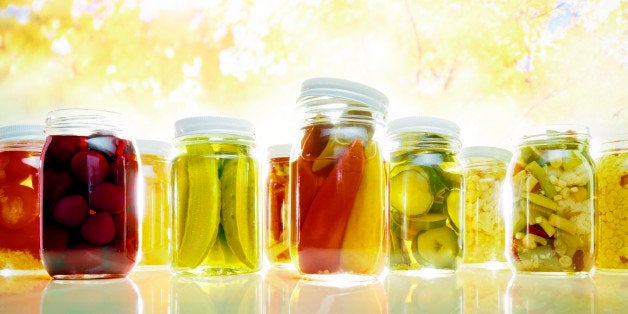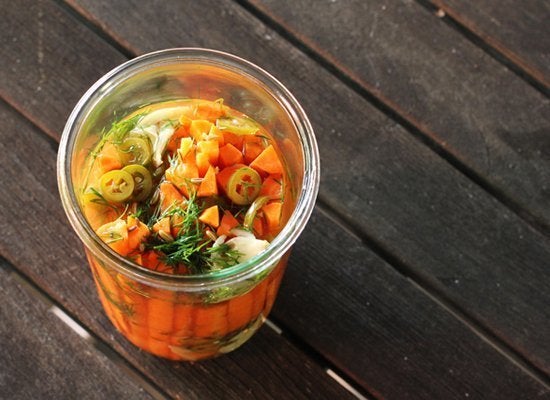
Confession time: I have been obsessed with pickles for my entire life. That's not the confession yet, I'll get to that. Some time around elementary school, my mother asked me what I'd like as my annual "big" Chanukah gift as we meandered up and down the aisles of Costco (undoubtedly gathering ingredients for a dinner party). My eyes landed on a two-gallon jar of sour dill pickles. "That," I said. And then we just sort of progressed from there.
The big confession is this: I never pickled anything myself until 2010, on the counter of a studio apartment in Brooklyn (yeah, duh, I know), after many self-pep-talks and weeks of research. Here's the truth: it's really not that hard. I made way too big a deal out of making my first pickles at home, and chances are that some of you are too. The great news is that once you've pickled a few things, completely ruined a few batches and had some unexpected successes, you can pretty much pickle anything. So, let's talk about how to pickle anything.
First, what you really need is a spirit guide. If you don't have a master pickler in your life (why don't we all get to have one of those?), a book will do. I started with two, and they have rarely led me astray:
- The Joy of Pickling: 250 Flavor-Packed Recipes for Vegetables for All Kinds of Produce from Garden or Market by Linda Zeidrich
- Wild Fermentation, by Sandor Ellix Katz
The Joy of Pickling has become my pickling Rosetta Stone. Anytime I bring home some strange vegetable and decide to pickle it, I check to see if Ziedrich already has a recipe for it. If not, I browse through the pickle recipes I've already made, imagining the flavor combinations of the brine settling into the vegetable (or fruit!) in question. It is an excellent primer for beginners, and includes everything from legit fermented pickles in barrels outside, to refrigerated vinegar pickles that anyone can make in any size kitchen. Wild Fermentation, on the other hand, has so far been a mostly educational and aspirational book. Katz is committed to the cultivation and consumption of fermented foods of all sorts -- from pickles to honey wine to tempeh and beyond. What Wild Fermentation has taught me is that you are probably not going to make anything inedible, and that sometimes mold is our friend. I can't recommend it enough.
Once you have your spirit guides in order, it's time to decide what to pickle first. Everyone always wants to start with cucumbers. They're the pickles we're most familiar with, and I don't blame anyone who loves them for wanting to recreate them at home. In my experience, cucumbers are some of the hardest things to pickle... at least as compared to the deli spears, sour dills and (go ahead, admit it) bright green hamburger chips we all love. My best advice: start with some other stuff first. A few of the earliest, best pickles I ever made:
- Mushrooms (Polish style, with allspice and onions -- they are an amazing addition to a cheese platter)
- Cauliflower (seems almost impossible to screw up)
- Brussels Sprouts (see above note on cauliflower)
- Asparagus (they are like sponges for brine)
- Carrots (perfectly crunchy every time, no matter what)
If you're thinking, "I really want to make pickles, but canning seems like it's a huge pain or I will give myself botulism." I hear you. Nearly every pickle I have ever made has been stored in the fridge for both of those reasons. The truth is really that canning isn't that hard, and there are excellent spirit guides out there for just this conundrum (check out Sherri Brooks Vinton's excellent Put 'em Up). The most important thing we want you to take away from this is: don't let that stop you.
Check out this great EatingWell primer on making fridge pickles, and start stocking your pantry and fridge with pickling ingredients, so you can pickle on a whim. Things like:
Vinegars
- Distilled, white vinegar
- Bragg's apple cider vinegar
- White wine vinegar
- Rice wine vinegar (if you want to make some Asian pickles -- which... you should)
Spices
- Black peppercorns
- Dried bay leaves
- Whole allspice
- Red pepper flakes
- Coriander seed
- Dill seeds
- Mustard seeds
Other Essentials
- Pickling salt (different from iodized or kosher salt, ground fine so it dissolves quickly)
- Garlic
- Fresh Dill
- Chiles
Obviously, I could go on and on, but I'll stop here. If you home-picklers out there (I know there are a ton of you) have any great tips for those just getting started, please let us know in the comments! We're all in this together guys. Now let's pickle all the things.
This story appears in Issue 70 of our weekly iPad magazine, Huffington, available Friday, Oct. 11 in the iTunes App store.
